

South China Sea: What's at stake. Tensions in the contest waters have ratcheted up since 2014 as China has turned sandbars into islands, equipping them with airfields, ports and weapons systems and warned US warships and aircraft to stay away from them.
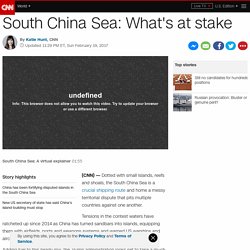
Adding fuel to this heady mix, the Trump administration looks set to take a much more confrontational stance toward Beijing than its predecessor -- setting the stage for a potential showdown. China bases its claims on the "nine-dash line" -- its claimed territorial waters that extend hundreds of miles to the south and east of its island province of Hainan, abut its neighbors' claims and, in some cases, encroach upon them. The Paracel Islands (Xisha to Beijing) have been controlled by China since 1974, but they are also claimed by Vietnam and Taiwan. Banned chemicals persist in deep ocean. Image copyright Dr Alan Jamieson, Newcastle Uni.
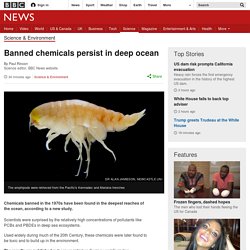
See How Pacific Islanders Are Living With Climate Change. Global temperatures hit record highs the past three years in a row—and the people of the Pacific have been feeling the effects.

The Pacific region has experienced devastating cyclones, storm surges, coral bleaching, and irregular rainfall patterns. Sea level rise threatens low-lying islands, where salt water infiltrates drinking water wells and kills staple food crops, as well as damaging property. Photographer Vlad Sokhin has been documenting environmental changes in Pacific communities since 2013. Sokhin focuses on indigenous communities who are adapting to challenges created primarily by carbon emissions from developed countries, he says.
Maritime piracy infographic 2013. Interactive: South China Sea disputes - Interactive. MarineTraffic: Global Ship Tracking Intelligence. Five Pacific islands disappear as sea levels rise. Image copyright Reuters/Simon Albert Five tiny Pacific islands have disappeared amid rising seas and erosion, Australian researchers say.
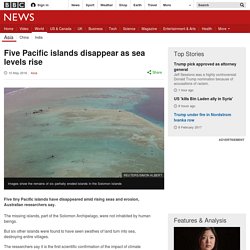
The missing islands, part of the Solomon Archipelago, were not inhabited by human beings. But six other islands were found to have seen swathes of land turn into sea, destroying entire villages. The researchers say it is the first scientific confirmation of the impact of climate change on Pacific coastlines. The study, published in Environmental Research Letters, looked at 33 islands using aerial and satellite imagery from 1947 to 2014, combined with historical insight and local knowledge. It found that the archipelago had seen sea levels rise as much as as 10mm (0.4in) every year for the past two decades.
Image copyright IOP Publishing Ltd The five that have vanished were all vegetated reef islands of up to five hectares (12 acres) in size that were occasionally used by fishermen but not populated. Image copyright AP. Ocean acidification in a cup - Digital Explorer - Media Player. United Nations Convention on the Law of the Sea. The United Nations Convention on the Law of the Sea lays down a comprehensive regime of law and order in the world's oceans and seas establishing rules governing all uses of the oceans and their resources.
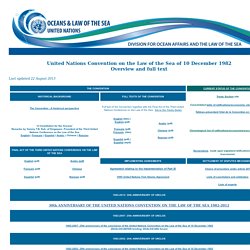
It enshrines the notion that all problems of ocean space are closely interrelated and need to be addressed as a whole. The Convention was opened for signature on 10 December 1982 in Montego Bay, Jamaica. Aquarius/SAC-D: ocean salinity taken by the Aquarius/SAC-D spacecraft. BBC Earth - Oceans - What can rubber ducks tell us about them? A global map of wind, weather, and ocean conditions. 11 Ways to See How Climate Change Is Imperiling the Arctic. While the average temperature of the planet is slowly creeping up, the Arctic is warming far more quickly—as much as two to three times faster.

On December 22, a weather buoy near the North Pole reported temperatures at the melting point of 32 degrees Fahrenheit. And recent research suggests that the average summer temperature in the region over the last century is higher than in any other century for at least 44,000 years. Maps and visualizations of the resulting changes in the Arctic make it clear that global warming is no hoax. Scientists are getting a vastly improved picture of what is happening in the Arctic today as sea-ice extent, thickness, and volume are tracked by satellites, ocean buoys, and submarines with upward-looking sonar. Lost at sea: The search for missing refugees.
The last time Gholam saw his wife and two children was in the brief moment before a high wave split their boat in half and catapulted the dozens of people on board towards the sea.

In the chaos of October 16, 2015, Gholam, an Afghan refugee from Kabul, held his eldest son's head above water so that he could breathe. But overcome by rough winds and unable to see in the darkness, he could not find his wife, their four-year-old son or their nine-year-old daughter. More than a year later, he still recalls desperately hanging on to a piece of wreckage as the shards of wood dug into his palms and feet. The true cost of shrimp. Shrimp: The trade from the Global South has hidden human and environmental impacts.
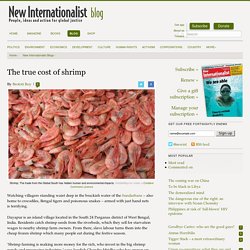
NatalieMaynor under a Creative Commons Licence Watching villagers standing waist deep in the brackish water of the Sundarbans – also home to crocodiles, Bengal tigers and poisonous snakes – armed with just hand nets is terrifying. Dayapur is an island village located in the South 24 Parganas district of West Bengal, India. Residents catch shrimp seeds from the riverbeds, which they sell for starvation wages to nearby shrimp farm owners. The Economist explains: Why the sea is salty. SEEN from space, the Earth is a pale blue dot.
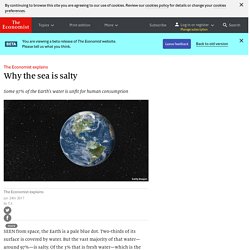
Two-thirds of its surface is covered by water. But the vast majority of that water—around 97%—is salty. Of the 3% that is fresh water—which is the kind humanity needs to drink, wash, make things and (most of all) produce food—about two-thirds is locked up in glaciers, ice caps and permafrost. Sea Level Rise. Core samples, tide gauge readings, and, most recently, satellite measurements tell us that over the past century, the Global Mean Sea Level (GMSL) has risen by 4 to 8 inches (10 to 20 centimeters).
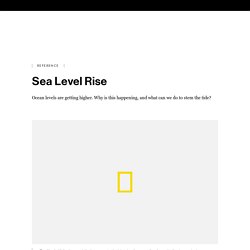
However, the annual rate of rise over the past 20 years has been 0.13 inches (3.2 millimeters) a year, roughly twice the average speed of the preceding 80 years. Over the past century, the burning of fossil fuels and other human and natural activities has released enormous amounts of heat-trapping gases into the atmosphere. These emissions have caused the Earth's surface temperature to rise, and the oceans absorb about 80 percent of this additional heat. The rise in sea levels is linked to three primary factors, all induced by this ongoing global climate change: Thermal Expansion: When water heats up, it expands. Consequences When sea levels rise rapidly, as they have been doing, even a small increase can have devastating effects on coastal habitats. How High Will It Go? UK wave power far too costly, warns energy research body.
An embryonic industry trying to harness the UK’s waves to generate clean electricity has been dealt a significant blow by a warning that the technology is too costly. Wave power devices being tested in Cornwall and at Orkney are 10 times more expensive than other sources of low carbon power and need a radical rethink, the Energy Technologies Institute (ETI) said. The energy research body added that even if costs were cut aggressively, wave power would be unlikely to make a significant contribution to the UK’s energy demands in coming decades.
The institute, which has a mission to accelerate low carbon technologies, said the UK’s marine energy strategy should instead prioritise support for tidal stream power, such as a project being tested in the Pentland Firth, which resembles underwater wind turbines. Why It's Important to Save Our Seas' Last Pristine Places. This story appears in the February 2017 issue of National Geographic magazine. Learn more about ocean life in Sea of Hope: America’s Underwater Treasures, premiering Sunday, January 15 at 7/6c on National Geographic. One hundred miles northeast of Boston Harbor, a half dozen endangered sei whales lunge and roll, sleek white bellies flashing in the gray North Atlantic. Despite climate change exodus, some Marshall Islanders head back home. Surrounded by 750,000 square miles of ocean, the low-lying Republic of the Marshall Islands (RMI) is emblematic of the threat climate change poses to small island nations.
This Micronesian country of coral atolls faces worsening droughts, tropical storms, coral bleaching, coastal inundation and flooding – all exacerbated by rising temperatures and sea levels. In the face of such an existential threat, the country has also seen a mass exodus of its inhabitants: exact numbers are unclear, but anything between one-fifth and one-third of the population has migrated visa-free to places such as Hawaii, the Pacific north-west and other parts of the US under an agreement called the Compact of Free Association. North-west Arkansas alone saw an increase of nearly 300% in its Marshallese population between 2000 and 2010.
Sustainability of Antarctic Krill. The sustainability of krill is about catching it in a way that does not compromise its ecosystem and future availability. It gained attention in the mainstream media over the last decade after a few studies suggested a connection between declining Antarctic krill (Euphausia superba) biomass and its predator populations in the southern ocean. Krill is positioned near the bottom of the marine food chain and is the primary food source for certain seabirds and mammals such as penguins, seals, whales, and albatross. Krill, a keystone in the marine ecosystem of southern oceans, fishing became a key concern in this sole commercially active Krill fishing ocean. To understand if Antarctic krill in the southern ocean is sustainable or not, let us review how various aspects of fishing krill have evolved into its current status and are expected to shape it in the future. Research on many of these aspects is insufficient and results thus far do not align in some cases.
Krill Conservation - Antarctic and Southern Ocean Coalition. The head of Antarctic krill. Photographed by Uwe Kils.ASOC is a key partner in the Antarctic Krill Conservation Project , whose goal is to protect the base of the Antarctic marine ecosystem – krill. Most marine species in the Southern Ocean – including whales, seals, penguins, albatrosses, petrels, squid and many others – feed on this small shrimp-like organism.
While the krill fishery has historically grown slowly, new technologies now allow catches to be processed more quickly, stimulating more interest in krill fishing from industry. CAMLR Convention. Sea Shepherd Conservation Society - Krill Fisheries, the Next Collapse? Commentary by Erwin Vermeulen. Krill – biology, ecology and fishing. China Aims High on Antarctic Krill. ASOC EBM Krill CCAMLR XXV. How The Krill Fishery Is Managed. Does One of the World’s Most Abundant Animals Need Protection from our Appetite? – Resilience. Plastic island: How our trash is destroying paradise. Daily chart: Sea ice reaches a new low. MEASURING sea ice is difficult.
Not only does it appear in the most remote, inhospitable parts of the world, it is constantly either melting or forming. Since 1979, satellites have made the job easier, but they can give a misleading picture. Piracy in Nigeria. £8bn tidal lagoon vision outlined to Cardiff council. Image copyright Tidal Lagoon Power An £8bn tidal lagoon in Cardiff Bay would be big enough to provide enough electricity for the whole of Wales, council leaders have been told.
BP Deepwater Horizon oil in land-animal food chain. Image copyright Andrea Bonisoli Alquati/www.andreabonisolialquati. Wave energy: Carnegie launches world-leading hub in Cornwall. Carnegie Wave Energy’s offshore energy-generating infrastructure is purposefully inconspicuous. Its patented CETO buoys, which resemble large circular tanks, are tethered to an anchor in the seafloor and remain fully submerged, out of sight. It’s a design feature that prioritises long-term survival in the ocean over efficiency in converting energy, says Michael Ottaviano, Carnegie’s managing director. "Trashzilla" protests against polluting of Hong Kong's oceans. Creating the world’s largest Marine Protected Area. Emily Penn: How Do Toxins From Plastics Find Their Way Into Our Food? Refugee crisis: More than 6,000 saved and nine dead in single day of Mediterranean rescue missions.
The waiting game: Aboard the Mediterranean's migrant rescue boats. Saving the World's Oceans is This Marine Biologist's Life Pursuit. Robert Ballard: The astonishing hidden world of the deep ocean. What a tiny porpoise in San Francisco Bay tells us about hope for our oceans. Global coral bleaching event might become new normal, expert warns. Scores drown after boat capsizes off Egypt's coast - News from Al Jazeera. Second lowest minimum for Arctic ice. Lives in the balance: climate change and the Marshall Islands. World's first large-scale tidal energy farm launches in Scotland. Three Nations Create Giant Reserves for Ocean Life. An Up-Close Look at Refugee Rescues on the Mediterranean. Shell begins production at world's deepest underwater oilfield. Defiantly drilling: the South China Sea 2016-09-13.
6 maps that could change your perspective on the world. No fishing, and minimal human activity – these are the 10 biggest marine reserves on the planet. Why Obama visited this tiny Pacific island. Soaring ocean temperature is 'greatest hidden challenge of our generation' Plastic microbeads to be banned by 2017, UK government pledges. Journey to the Arctic. Obama to create world's largest protected marine area off Hawaii.
One of the World's Biggest Fisheries Is on The Verge of Collapse. Migrant crisis: 'They couldn't wait... they threw themselves into the water'. Venomous Snakes Ride Ocean Currents Around the World. Microplastics should be banned in cosmetics to save oceans, MPs say. 'The North Pole could ice-free by next summer' NASA Monitors 'New Normal' of Sea Ice. This disturbing map shows just how much plastic is floating in our oceans. The deep ocean: plunging to new depths to discover the largest migration on Earth. We are eating more fish than ever. Can our oceans cope? Protect ocean ecosystems, not exploit them, is what the ISA must do. PACE Will Reveal New Information on Ocean Health.
5 reasons it might be ok to be optimistic about our oceans. A Plastic Ocean. Taiwan lawmakers visit disputed island after court ruling. UK expedition explores potential and risks of deep sea gold rush. UN: Global fish consumption per capita hits record high. How China's trawlers are emptying Guinea's oceans. South China Sea: Hague rules in favor of Philippines over China in maritime dispute. Beijing blames Philippines for South China Sea trouble - News from Al Jazeera. A good day for the Philippines. Why Huge Amounts Of Garbage Are Washing Up On Hong Kong's Shores.
The Ocean Could Be the New Gold Rush.